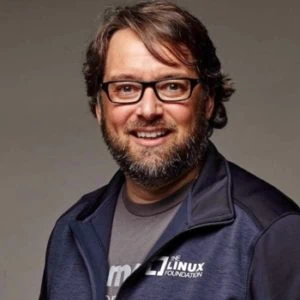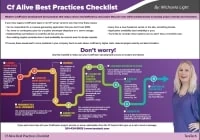Bret Fisher talks about “The Docker Revolution for Faster ColdFusion Development (and Easier DevOps)” in this episode of the CF Alive Podcast, with host Michaela Light.
Contents
- Show notes
- Docker containers have revolutionized much of how we build, ship, and run the software.
- The key benefits for choosing to deploy CF and Mura on the Docker toolset
- Why are you proud to use Docker?
- WWIT to make Docker more alive this year?
- What are you looking forward to at MuraCon?
- Mentioned in this episode
- Session Descriptions
- Listen to the Audio
- Bio
- Links
- Interview Transcript
Show notes
Docker containers have revolutionized much of how we build, ship, and run the software.
- Bret will highlight the far-reaching effects of this pivotal technology and how it's blazing a trail for the future of app development and deployment.
- 5 birthday of Docker
- 300 meetups
The key benefits for choosing to deploy CF and Mura on the Docker toolset
- Developers
- Docker for Mac or Windows runs Linux Docker containers
- Build
- CI and CD
- CIDE
- Docker Build tool
- YAML file that describes your app
- Docker Compose
- DevOps
- CD = Continuous Deployment
- Agile deployments
- Docker image package format
- Code, config and all its dependencies
- Docker hub
- AWS elastic container service
- Orchestration
- SHA-1 hashed for security
- Windows 2016 has Docker support built in
Downsides to Docker
- Learning curve, new concepts.
- Make it a goal to replace a tool, not add to your tool list
The dev-staging-prod pipeline
- Basic “daily docker commands” for working with software on your machine.
- Go to store.Docker.com to get current and correct install instructions for your version of Windows, Linux etc
- Docker compose command line
- Docker compose up and down
- CommandBox
- Commit to version control
- CI tool (eg Jenkins) → continuous testing → green light (passes all tests)
- Push good image to container registry
- Keeps old versions (via diffs only)
- Tagged images
- Pull down to staging or production and run
Local dev environment benefits
- Consistency
- between devs
- between dev and prod
- Isolation of different CF versions etc for different projects
- Faster set up for new devs on team or new projects
- From 12 page set up a guide to 1 page
- Can run Linux or Windows CF
A platform of tools for devs and DevOps
- Docker-Machine to manage local and cloud containers
- Docker Swarm (built into Docker)
- Your existing cloud vendor’s Docker tools
- DO simplicity
- Docker is pre-installed for droplets
- Docker Machine driver built in
- AWS – lots of features and tools
- 3 different Docker deploy options
- ACS is easiest
- 3 different Docker deploy options
- Microsoft Azure new features
- DO simplicity
- CommandBox
Why are you proud to use Docker?
WWIT to make Docker more alive this year?
What are you looking forward to at MuraCon?
Mentioned in this episode
-
Docker for Windows or Mac
-
Docker Build
-
YAML file
-
Kubernetes
-
Netflix Chaos Monkey
-
Docker Swarm
-
Portainer episode
-
Rancher
-
CNCF Diagram of container ecosystem
-
Awesome Docker
-
Code for America
-
DockerCon in US and EU
-
CommandBox
-
Bret’s slides
-
Bret’s Udemy Docker course
-
Bret’s YouTube Docker videos
-
Bret’s GitHub Docker AMA
Session Descriptions
How Docker is Changing IT
Docker containers are a 5-year old project that has revolutionized much of how we build, ship, and run software. Bret will highlight the far-reaching effects of this pivotal technology and how it's blazing a trail for the future of app development and deployment.
Workshop: Intro to Docker & Containers
This fast-paced hands-on workshop will take you from Docker 101 to an understanding of how to use Docker Compose for easy local Mura development. You'll learn which Docker edition is right for you and your laptop OS, and get it working in the workshop (if you don't already have it). Bret will teach you some basic “daily docker commands” for working with software on your machine. You'll get plenty of background on the “what, why, and how” on Docker for development while getting your hands dirty running and managing containers.
Journey to Docker Production
Bret and Eddie will take you through many of the factors that will help you be successful in creating a production-ready Docker server cluster, including Docker best practices and Docker Swarm infrastructure templates. They'll show off some example configurations specific to Mura, as well as complementary solutions that will be necessary for production. You'll take away some key benefits for choosing to deploy Mura on the Docker toolset.
Listen to the Audio
Podcast: Play in new window | Download | Embed
Subscribe: RSS
Bio
Bret Fisher
For 25 years Bret has built and operated distributed systems as a Sysadmin and helped over 30,000 people learn dev and ops topics. He is a Docker Captain, the author of the wildly popular Docker Mastery series on Udemy, and also provides DevOps style consulting and live workshops with a focus on immutable infrastructures, containers, and orchestration. Bret's an occasional shell and web, and JavaScript developer. He spends his free time in Virginia's local, thriving tech scene helping lead local Code for America and Docker Meetups. Bret basically spends his days helping people, and giving high fives. He lives at the beach, writes at bretfisher.com, prefers dogs over cats, and tweets at @bretfisher
Links
Interview Transcript
Michaela: Welcome back to the show. And today, we're going to look at the Docker revolution for faster ColdFusion and easier devops with Bret Fisher. And we're going to look at the revolution in how we build ship and run software using Docker containerization. And some of the key [inaudible] [00:18] benefits of choosing Docker to deploy your ColdFusion apps. And Bret is going to be speaking at Miracon in a few weeks. So in particular, we’ll focus on the Miracon CMS that's written in ColdFusion. But all that stuff applies to any ColdFusion app. And we'll look at some of the downsides of ColdFusion. We’ll look at the your dev stage of production pipeline, how you might set up your local dev environment with Docker Best, and some of the tools you can use.
We’ll mention Docker Compose and we’ll have a talk about some of the basic daily Docker commands that would be really good to know. So lot more things coming up in this episode. We'll see what we can fit in here because if you don't know, Bret is a Docker captain and he is author of one of the most popular Udemy courses on Docker, and has some great YouTube videos on setting yourself up in Docker. So he's a real Docker expert and he loves to give high fives to people. And he's speaking at about 12 conferences including Miracon in the next three months. So welcome Bret.
Bret: Thanks for having me. Yes, it is. It should be the Bret world tour I believe at this point. So it's going to be a lot of fun.
Michaela: Excellent! So tell us a bit about the Docker revolution in building and deploying and running software?
Read more
And to continue learning how to make your ColdFusion apps more modern and alive, I encourage you to download our free ColdFusion Alive Best Practices Checklist.
Because… perhaps you are responsible for a mission-critical or revenue-generating CF application that you don’t trust 100%, where implementing new features is a painful ad-hoc process with slow turnaround even for simple requests.
What if you have no contingency plan for a sudden developer departure or a server outage? Perhaps every time a new freelancer works on your site, something breaks. Or your application availability, security, and reliability are poor.
And if you are depending on ColdFusion for your job, then you can’t afford to let your CF development methods die on the vine.
You’re making a high-stakes bet that everything is going to be OK using the same old app creation ways in that one language — forever.
All it would take is for your fellow CF developer to quit or for your CIO to decide to leave the (falsely) perceived sinking ship of CFML and you could lose everything—your project, your hard-won CF skills, and possibly even your job.
Luckily, there are a number of simple, logical steps you can take now to protect yourself from these obvious risks.
No Brainer ColdFusion Best Practices to Ensure You Thrive No Matter What Happens Next
ColdFusion Alive Best Practices Checklist
Modern ColdFusion development best practices that reduce stress, inefficiency, project lifecycle costs while simultaneously increasing project velocity and innovation.
√ Easily create a consistent server architecture across development, testing, and production
√ A modern test environment to prevent bugs from spreading
√ Automated continuous integration tools that work well with CF
√ A portable development environment baked into your codebase… for free!
Learn about these and many more strategies in our free ColdFusion Alive Best Practices Checklist.

